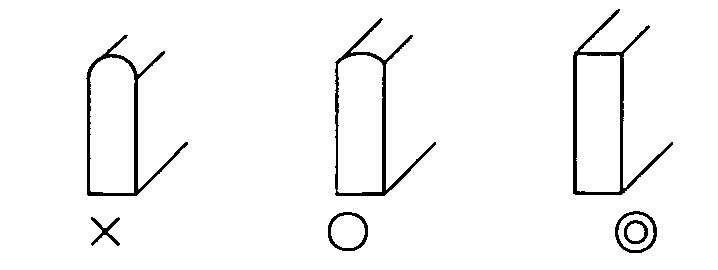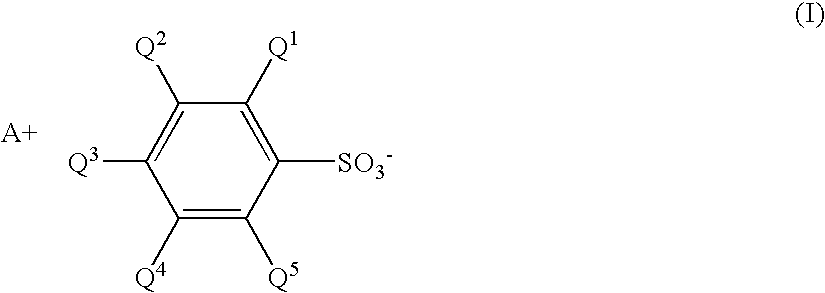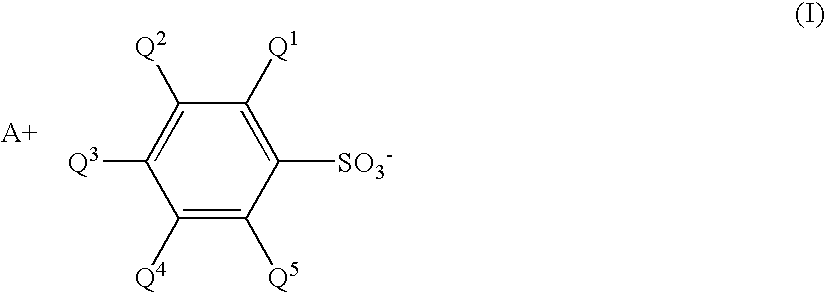Sulfonate and resist composition
- Summary
- Abstract
- Description
- Claims
- Application Information
AI Technical Summary
Benefits of technology
Problems solved by technology
Method used
Image
Examples
synthesis example 1
RESIN SYNTHESIS EXAMPLE 1
Synthesis of Resin A1
[0137] 2-Ethyl-2-adamantyl methacrylate, 5-methacryloyloxy-2,6-norbornenelactone and α-methacryloyloxy-γ-butyrolactone were charged at a molar ratio of 35:40:25 (12.42 g:12.70 g:5.58 g), and 30.70 g of 1,4-dioxane was added, and then was added 0.70 g of azobisisobutyronitrile as an initiator to prepare solution. In another flask, 46.04 g of 1,4-dioxane was charged and heated to 87° C. To this was added the solution obtained above over one hour and the mixture was stirred for 5 hours maintaining the temperature. Then, operation of pouring into large amount of n-heptane to cause crystallization was repeated three times for purification, and then dried to obtain 25.4 g (Yield: 82.7%) of copolymer having an average molecular weight of 8900. This is called resin A1.
synthesis example 2
RESIN SYNTHESIS EXAMPLE 2
Synthesis of Resin A2
[0138] 2-Ethyl-2-adamantyl methacrylate, 3-hydroxy-1-adamantyl methacrylate and α-methacryloyloxy-γ-butyrolactone were charged at a molar ratio of 5:2.5:2.5 (20.0 parts:9.5 parts:7.3 parts), and methyl isobutyl ketone in twice weight based on all monomers was added, to prepare solution. To the solution was added azobisisobutyronitrile as an initiator in a ratio of 2 mol % based on all monomer molar amount, and the mixture was heated at 80° C. for about 8 hours. Then, the reaction solution was poured into large amount of heptane to cause precipitation, and this operation was repeated three times for purification. As a result, copolymer having a weight-average molecular weight of about 9,200 was obtained. This is called resin A2.
[0139] As Resin A3, IHM-55-10K(Trade No., the product of Mitsubishi Rayon Co., Ltd., mixture of structural units of MAMA and HGBME each of which structure is shown below, ratio of MAMA / HGBMA=1 / 1) was used.
[0140...
PUM
| Property | Measurement | Unit |
|---|---|---|
| Percent by mass | aaaaa | aaaaa |
| Temperature | aaaaa | aaaaa |
| Temperature | aaaaa | aaaaa |
Abstract
Description
Claims
Application Information
 Login to View More
Login to View More - R&D
- Intellectual Property
- Life Sciences
- Materials
- Tech Scout
- Unparalleled Data Quality
- Higher Quality Content
- 60% Fewer Hallucinations
Browse by: Latest US Patents, China's latest patents, Technical Efficacy Thesaurus, Application Domain, Technology Topic, Popular Technical Reports.
© 2025 PatSnap. All rights reserved.Legal|Privacy policy|Modern Slavery Act Transparency Statement|Sitemap|About US| Contact US: help@patsnap.com



